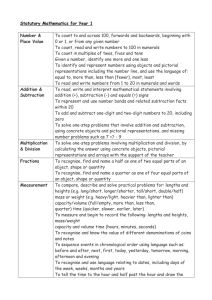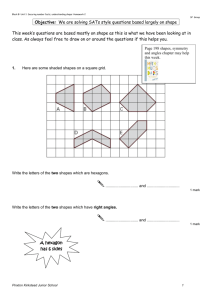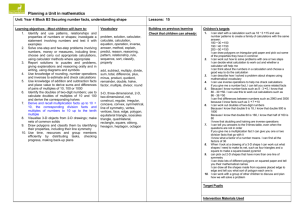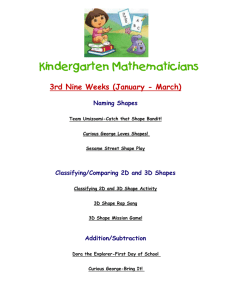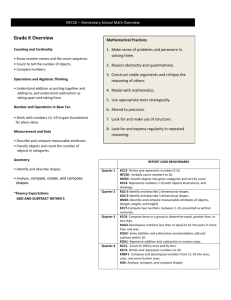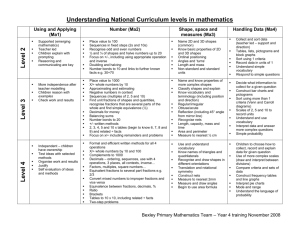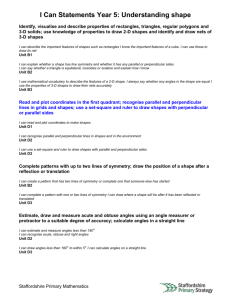Y2 Block B Unit 2
advertisement
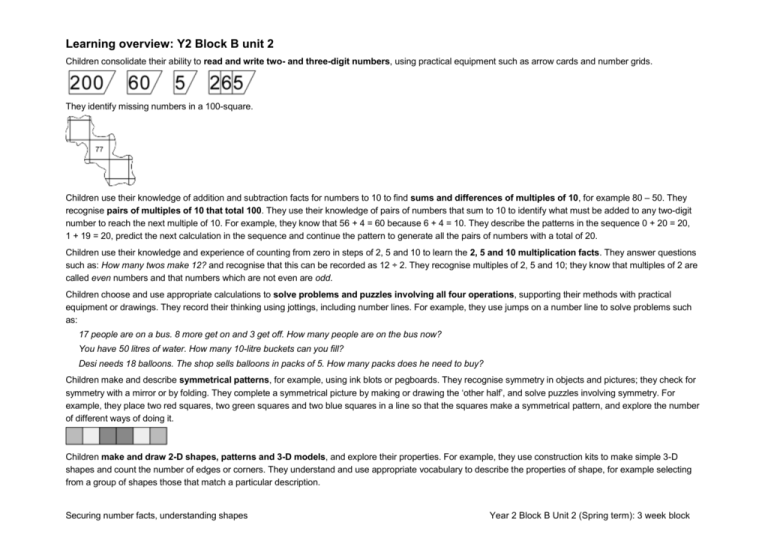
Learning overview: Y2 Block B unit 2 Children consolidate their ability to read and write two- and three-digit numbers, using practical equipment such as arrow cards and number grids. They identify missing numbers in a 100-square. Children use their knowledge of addition and subtraction facts for numbers to 10 to find sums and differences of multiples of 10, for example 80 – 50. They recognise pairs of multiples of 10 that total 100. They use their knowledge of pairs of numbers that sum to 10 to identify what must be added to any two-digit number to reach the next multiple of 10. For example, they know that 56 + 4 = 60 because 6 + 4 = 10. They describe the patterns in the sequence 0 + 20 = 20, 1 + 19 = 20, predict the next calculation in the sequence and continue the pattern to generate all the pairs of numbers with a total of 20. Children use their knowledge and experience of counting from zero in steps of 2, 5 and 10 to learn the 2, 5 and 10 multiplication facts. They answer questions such as: How many twos make 12? and recognise that this can be recorded as 12 ÷ 2. They recognise multiples of 2, 5 and 10; they know that multiples of 2 are called even numbers and that numbers which are not even are odd. Children choose and use appropriate calculations to solve problems and puzzles involving all four operations, supporting their methods with practical equipment or drawings. They record their thinking using jottings, including number lines. For example, they use jumps on a number line to solve problems such as: 17 people are on a bus. 8 more get on and 3 get off. How many people are on the bus now? You have 50 litres of water. How many 10-litre buckets can you fill? Desi needs 18 balloons. The shop sells balloons in packs of 5. How many packs does he need to buy? Children make and describe symmetrical patterns, for example, using ink blots or pegboards. They recognise symmetry in objects and pictures; they check for symmetry with a mirror or by folding. They complete a symmetrical picture by making or drawing the ‘other half’, and solve puzzles involving symmetry. For example, they place two red squares, two green squares and two blue squares in a line so that the squares make a symmetrical pattern, and explore the number of different ways of doing it. Children make and draw 2-D shapes, patterns and 3-D models, and explore their properties. For example, they use construction kits to make simple 3-D shapes and count the number of edges or corners. They understand and use appropriate vocabulary to describe the properties of shape, for example selecting from a group of shapes those that match a particular description. Securing number facts, understanding shapes Year 2 Block B Unit 2 (Spring term): 3 week block Year 2 Block B Unit 2 (Spring term): 3 week block Securing number facts, understanding shapes Learning objectives 1999 links Derive and recall all addition and subtraction facts for each number to at least 10, all pairs with totals to 20 and all pairs of multiples of 10 with totals up to 100 Year 2 31 Derive and recall multiplication facts for the 2, 5 and 10 times-tables and the related division facts; recognise multiples of 2, 5 and 10 Year 2 Read and write two-digit and three-digit numbers in figures and words; describe and extend number sequences and recognise odd and even numbers Visualise common 2-D shapes and 3-D solids; identify shapes from pictures of them in different positions and orientations; sort, make and describe shapes, referring to their properties Identify reflective symmetry in patterns and 2-D shapes and draw lines of symmetry in shapes 53 & Year 3 53 Year 2 3, 5, 7, 9 Year 2 81, 83 Year 2 85 Focus of using and applying Year 2 Describe patterns and relationships involving numbers or shapes, make predictions and test these with examples 63, 65 Solve problems involving addition, subtraction, multiplication or division in contexts of numbers, measures or pounds and pence 67, 69 Year 2 Vocabulary problem, solution, calculate, calculation, operation, inverse, answer, method, explain, predict, reason, pattern, relationship, sort, classify, property add, subtract, multiply, divide, sum, total, difference, plus, minus, multiple, odd, even square, rectangle, rectangular, triangle, triangular, circle, circular, pentagon, hexagon, octagon, pyramid, cube, cuboid, sphere, cone, cylinder, face, corner, edge, side, flat, curved, surface, straight, round, shape, hollow, solid, line of symmetry, fold, mirror line, reflection Building on previous learning Check that children can already • • • describe simple patterns and relationships involving numbers or shapes solve problems involving counting, adding, subtracting, doubling or halving in the context of numbers, measures or money; recognise the value of coins recall addition and subtraction facts to 10 and doubles of all numbers to at least 10 use informal written methods to add or subtract a one-digit number or multiple of 10 to or from a two-digit number, recording an addition or subtraction number sentence • name common 2-D shapes and 3-D solids and describe their features • use diagrams to sort objects into groups according to a given criterion Children's targets I can recall number facts for each number up to 10 I know which pairs of numbers make 20 I know some of the number facts in the 2, 5 and 10 times-tables I know that multiples of 2 are even numbers I can describe the patterns in a set of calculations. I can explain how I know I can use a construction kit to make a model of a 3-D solid that I know I can make a symmetrical pattern using coloured tiles I can draw a line of symmetry on a shape UAM children’s targets I can complete a symmetrical picture by drawing the ‘other half’ I can decide which calculations to do to solve a problem Speaking and listening children’s targets I know the proper names of a cube, a cylinder, a cone and a pyramid. I can point to parts of them as I describe them Focus on speaking and listening: Use language and gesture to support the use of models, diagrams or displays when explaining Securing number facts, understanding shapes Year 2 Block B Unit 2 (Spring term): 3 week block Block E unit 3 Block D unit 3 Block C unit 3 Block B unit 3 Block A unit 3 Block E unit 2 Block D unit 2 Block C unit 2 Block B unit 2 Block A unit 2 Block E unit 1 Derive and recall multiplication facts for the 2, 5 and 10 times-tables and the related division facts; recognise multiples of 2, 5 and 10 Securing number facts, understanding shapes Understand that halving is the inverse of doubling and derive and recall doubles of all numbers to 20, and the corresponding halves Visualise common 2-D shapes and 3-D solids; identify shapes from pictures of them in different positions and orientations; sort, make and describe shapes, referring to their properties Identify reflective symmetry in patterns and 2-D shapes and draw lines of symmetry in shapes Block D unit 1 Derive and recall all addition and subtraction facts for each number to at least 10, all pairs with totals to 20 and all pairs of multiples of 10 with totals up to 100 Use knowledge of number facts and operations to estimate and check answers to calculations Block C unit 1 Solve problems involving addition, subtraction, multiplication or division in contexts of numbers, measures or pounds and pence Read and write two-digit and three-digit numbers in figures and words; describe and extend number sequences and recognise odd and even numbers Block B unit 1 Block A unit 1 Year 2 Block B Describe patterns and relationships involving numbers or shapes, make predictions and test these with examples Year 2 Block B Unit 2 (Spring term): 3 week block Week Mental/Oral (rehearse, recall, 1 refine, reason, revisit, read) Objectives Activity Main Activity Objectives Key vocabulary Plenary Direct teaching Key questions Activities - (considering lower, middle and higher achievers) Indicate organisation and support. Resources (incl ICT) Review, reflect. Key questions Mon Tues Wed Thur Fri Assessment and future action Securing number facts, understanding shapes Homework Year 2 Block B Unit 2 (Spring term): 3 week block Week Mental/Oral (rehearse, recall, 2 refine, reason, revisit, read) Objectives Activity Main Activity Objectives Key vocabulary Plenary Direct teaching Key questions Activities - (considering lower, middle and higher achievers) Indicate organisation and support. Resources (incl ICT) Review, reflect. Key questions Mon Tues Wed Thur Fri Assessment and future action Securing number facts, understanding shapes Homework Year 2 Block B Unit 2 (Spring term): 3 week block Week Mental/Oral (rehearse, recall, 3 refine, reason, revisit, read) Objectives Activity Main Activity Objectives Key vocabulary Plenary Direct teaching Key questions Activities - (considering lower, middle and higher achievers) Indicate organisation and support. Resources (incl ICT) Review, reflect. Key questions Mon Tues Wed Thur Fri Assessment and future action Securing number facts, understanding shapes Homework Year 2 Block B Unit 2 (Spring term): 3 week block

